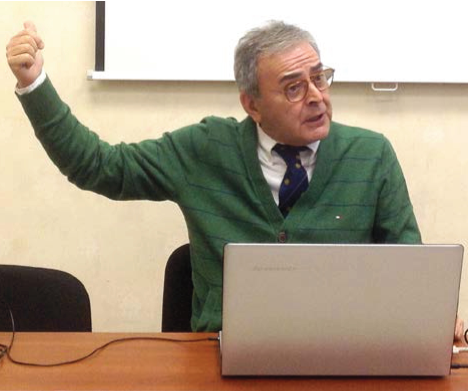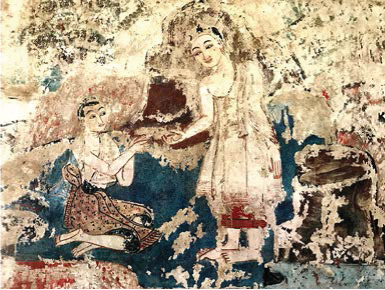Vol 1, No 3-4 (2018)
View or download the full issue
PDF (Russian)
HISTORY OF THE EAST. Universal history 
371-393 579
Abstract
It is considered to be that the iconography of Theravada embodies the real or legendary events of the life of the Buddha Gautama (Gotama). Using the episode of the Bodhisattva (Bodhisatta) meeting with Sotthiya as an example, the article analyzes the stability of the iconographic code that reflects the life of the founder of Buddhism. The development of the episode in Buddhist iconography is traced from the art of Gandhara through the samples of Dvaravati Mons, Burmese Pagan, temple wall paintings of Burma and Siam 17-18th centuries up to the modern iconography of Myanmar and Thailand.
394-401 765
Abstract
This article concerns the origin of the early Buddhist term tathagata (on Pali and Sanskrit material). This way, if you judge according to the Pali Canon, is of ancient pre-Buddhist origin. The “Digha-Nikaya” Sutras provides us with a number of nontrivial contexts of the use of this word, allowing us to accurately establish its etymology and literal meaning. In addition, these contexts suggest a special connection of Tathagata (as an image of the Buddha) with “truth telling”.
HISTORY OF THE EAST. Historiography, source critical studies, historical research methods 
402-422 944
Abstract
The paper deals with a little-known and virtually unexplored group of early 20th century epigraphic monuments from central Semirechye (the lower course of Chon Kemin river), belonging to the clan of Tynaï of the Sarybaghysh tribe. A detailed analysis is carried out with regard to the sepulchral inscriptions on stone tombs (stelae) dedicated to the renowned Qyrghyz (Kyrgyz) manap Shabdan son of Jantaï, his two brothers and two underage daughters, all deceased and buried between 1904 and 1912.
HISTORY OF SCIENCE. Oriental Studies 
424-460 1748
Abstract
The article offers an account on the history of the Department of Chinese Studies at the Institute of the Oriental Studies of the Russian Academy in 1960-1980. This is one of the most important centres of Chinese Studies in the former USSR and in the post-soviet Russia. The article deals with its origins, scholarly activities, and achievements as well as the members of staff. The scholarly achievements are outlined in the context of the complex relationship between the Communist party’s views on the Chinese history and the actual findings, which had to be put in accordance with the view of the Party. The ideological censorship was acerbated by the complex and not always easy relations between the Chinese and Soviet communist ideologies on one hand and the USSR and the Peoples Republic of China on the other
PHILOSOPHY OF THE EAST. Philosophy of religion and religious studies 
461-488 587
Abstract
This is a continuation of the translation into Russian of the treatise al-Isharat wa-t-Tanbihat (“Remarks and Admonitions”) by Ibn-Sina (Avicenna, 980- 1037). The present article comprises the Chapter 5 of Avicenna’s treatise, which deals with the state of the Necessary Existent (i.e. God) as First Principle, discusses various modes for bringing things into being and criticizes the thesis about the temporal finitism. The chapter also contains a justification of the eternal invention (ibda’) as a supreme level of creation, which is most adequately expresses the Divine absolute perfection
LITERATURE OF THE EAST. Literature of the peoples of foreign countries 
489-512 2212
Abstract
Translation and hermeneutics of the classical Persian ghazal are among the urgent problems of Iranian philology. The article includes philological translations of the two ghazals of Shams al-Din Muhammad Hafiz (14th century) accompanied by a detailed line by line poetic commentary. The introduction to the publication outlines the concept underlying the project of the full translation of the “Divan” by Hafiz into Russian
CHRONICLE. Conference report 
513-533 515
Abstract
In 2018 the 8th International Conference “Written Monuments of the East. Translation and Interpretation Problems” (October 31, 2018 - November 2, 2018) was dedicated to the 200th anniversary of the Institute of Oriental Studies, Russian Academyof Sciences. At the conference sessions more than 40 papers were presented byscholars from Moscow, St. Petersburg, Ufa, Yerevan, Tbilisi, Cambridge, Leiden, London,Rome and Toronto. All of them were devoted to the study of the classical heritage ofthe East - manuscripts and visual arts, folklore, religion and mythology. This explainsthe growing popularity of our conference, year by year, its expanding thematicspectrum and range of participants. As in previous years, the conference’s organizerwas the Institute of Oriental Studies, Russian Academy of Sciences (Department ofWritten Monuments of the East).
534-538 240
Abstract
Two glorious centuries!
FROM THE EDITOR 
Personalia in Memoriam 
539-552 508
Abstract
The article deals with the biography and scholarly achievements of the outstanding Georgian scholar of Iran Dzhemshid Giunashvili (d. 2017). The authors have placed the life of Dzh. Giunashvili into the broad context of the Oriental Studies as scholarly subject in the former Soviet Union and the post-Soviet Georgia. Being a Georgian by birth Dzh. Giunashvili also belonged to the culture of Iran; Persian was hismother tongue. This fact contributed to the outstanding position, which he took evenamong the Great Soviet specialists and scholars of Iran in the 20th century. Later in life,Dzh. Giunashvili became the first Georgian Ambassador to Iran.
ISSN 2618-7043 (Print)
ISSN 2687-0738 (Online)
ISSN 2687-0738 (Online)

























